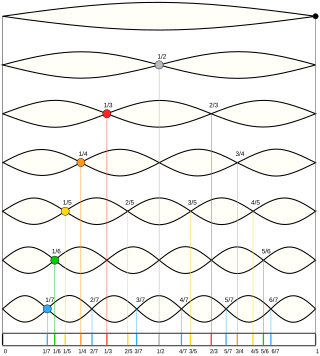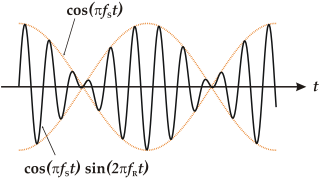
In music, there are two common meanings for tuning:

A tuning fork is an acoustic resonator in the form of a two-pronged fork with the prongs (tines) formed from a U-shaped bar of elastic metal. It resonates at a specific constant pitch when set vibrating by striking it against a surface or with an object, and emits a pure musical tone once the high overtones fade out. A tuning fork's pitch depends on the length and mass of the two prongs. They are traditional sources of standard pitch for tuning musical instruments.

A harmonic is a wave with a frequency that is a positive integer multiple of the fundamental frequency, the frequency of the original periodic signal, such as a sinusoidal wave. The original signal is also called the 1st harmonic, the other harmonics are known as higher harmonics. As all harmonics are periodic at the fundamental frequency, the sum of harmonics is also periodic at that frequency. The set of harmonics forms a harmonic series.
In telephony, single-frequency signaling (SF) is line signaling in which dial pulses or supervisory signals are conveyed by a single voice-frequency tone in each direction. SF and similar systems were used in 20th-century carrier systems.
In telecommunication, a standard test signal is a single-frequency signal with standardized level used for testing the peak power transmission capability and for measuring the total harmonic distortion of circuits or parts of an electric circuit.

MIL-STD-188 is a series of U.S. military standards relating to telecommunications.
A signal generator is one of a class of electronic devices that generates electrical signals with set properties of amplitude, frequency, and wave shape. These generated signals are used as a stimulus for electronic measurements, typically used in designing, testing, troubleshooting, and repairing electronic or electroacoustic devices, though it often has artistic uses as well.

Pitch is a perceptual property of sounds that allows their ordering on a frequency-related scale, or more commonly, pitch is the quality that makes it possible to judge sounds as "higher" and "lower" in the sense associated with musical melodies. Pitch is a major auditory attribute of musical tones, along with duration, loudness, and timbre.

Audio system measurements are a means of quantifying system performance. These measurements are made for several purposes. Designers take measurements so that they can specify the performance of a piece of equipment. Maintenance engineers make them to ensure equipment is still working to specification, or to ensure that the cumulative defects of an audio path are within limits considered acceptable. Audio system measurements often accommodate psychoacoustic principles to measure the system in a way that relates to human hearing.
A440 (also known as Stuttgart pitch) is the musical pitch corresponding to an audio frequency of 440 Hz, which serves as a tuning standard for the musical note of A above middle C, or A4 in scientific pitch notation. It is standardized by the International Organization for Standardization as ISO 16. While other frequencies have been (and occasionally still are) used to tune the first A above middle C, A440 is now commonly used as a reference frequency to calibrate acoustic equipment and to tune pianos, violins, and other musical instruments.
In telecommunications, a pilot signal is a signal, usually a single frequency, transmitted over a communications system for supervisory, control, equalization, continuity, synchronization, or reference purposes.

Piano tuning is the act of adjusting the tension of the strings of an acoustic piano so that the musical intervals between strings are in tune. The meaning of the term 'in tune', in the context of piano tuning, is not simply a particular fixed set of pitches. Fine piano tuning requires an assessment of the vibration interaction among notes, which is different for every piano, thus in practice requiring slightly different pitches from any theoretical standard. Pianos are usually tuned to a modified version of the system called equal temperament.

An equal-loudness contour is a measure of sound pressure level, over the frequency spectrum, for which a listener perceives a constant loudness when presented with pure steady tones. The unit of measurement for loudness levels is the phon and is arrived at by reference to equal-loudness contours. By definition, two sine waves of differing frequencies are said to have equal-loudness level measured in phons if they are perceived as equally loud by the average young person without significant hearing impairment.
Audiometry is a branch of audiology and the science of measuring hearing acuity for variations in sound intensity and pitch and for tonal purity, involving thresholds and differing frequencies. Typically, audiometric tests determine a subject's hearing levels with the help of an audiometer, but may also measure ability to discriminate between different sound intensities, recognize pitch, or distinguish speech from background noise. Acoustic reflex and otoacoustic emissions may also be measured. Results of audiometric tests are used to diagnose hearing loss or diseases of the ear, and often make use of an audiogram.

Secure voice is a term in cryptography for the encryption of voice communication over a range of communication types such as radio, telephone or IP.

Sub-bass sounds are the deep, low-register pitches below approximately 70 Hz (C♯2 in scientific pitch notation) and extending downward to include the lowest frequency humans can hear, approximately 20 Hz (E0).

In acoustics, a beat is an interference pattern between two sounds of slightly different frequencies, perceived as a periodic variation in volume whose rate is the difference of the two frequencies.

In music, an electronic tuner is a device that detects and displays the pitch of musical notes played on a musical instrument. "Pitch" is the perceived fundamental frequency of a musical note, which is typically measured in Hertz. Simple tuners indicate—typically with an analog needle or dial, LEDs, or an LCD screen—whether a pitch is lower, higher, or equal to the desired pitch. Since the early 2010s, software applications can turn a smartphone, tablet, or personal computer into a tuner. More complex and expensive tuners indicate pitch more precisely. Tuners vary in size from units that fit in a pocket to 19" rack-mount units. Instrument technicians and piano tuners typically use more expensive, accurate tuners.
In telecommunication, a measuring receiver or measurement receiver is a calibrated laboratory-grade radio receiver designed to measure the characteristics of radio signals. The parameters of such receivers can usually be adjusted over a much wider range of values than is the case with other radio receivers. Their circuitry is optimized for stability and to enable calibration and reproducible results. Some measurement receivers also have especially robust input circuits that can survive brief impulses of more than 1000 V, as they can occur during measurements of radio signals on power lines and other conductors.

A-weighting is the most commonly used of a family of curves defined in the International standard IEC 61672:2003 and various national standards relating to the measurement of sound pressure level. A-weighting is applied to instrument-measured sound levels in an effort to account for the relative loudness perceived by the human ear, as the ear is less sensitive to low audio frequencies. It is employed by arithmetically adding a table of values, listed by octave or third-octave bands, to the measured sound pressure levels in dB. The resulting octave band measurements are usually added to provide a single A-weighted value describing the sound; the units are written as dB(A). Other weighting sets of values – B, C, D and now Z – are discussed below.
![]() 1000 Hz tone (help·info) at −20dB. It is meant to be used by audio engineers in order to adjust the playback equipment so that the accompanying media is at a comfortable volume for the audience. In video production, this tone is usually accompanied by a test card so the video programming may be calibrated as well. It is sometimes played in sequence between a 100 Hz and 10 kHz tone to ensure an accurate response from the equipment at varying audio frequencies. This is also the "bleep" tone commonly used to censor obscene or sensitive audio content.
1000 Hz tone (help·info) at −20dB. It is meant to be used by audio engineers in order to adjust the playback equipment so that the accompanying media is at a comfortable volume for the audience. In video production, this tone is usually accompanied by a test card so the video programming may be calibrated as well. It is sometimes played in sequence between a 100 Hz and 10 kHz tone to ensure an accurate response from the equipment at varying audio frequencies. This is also the "bleep" tone commonly used to censor obscene or sensitive audio content.











